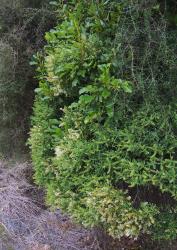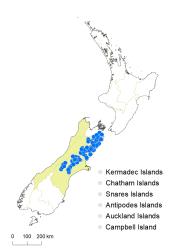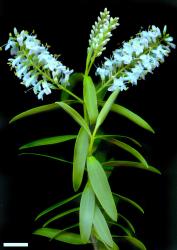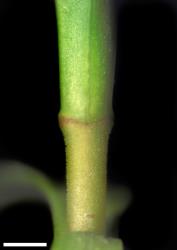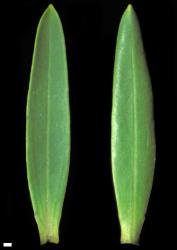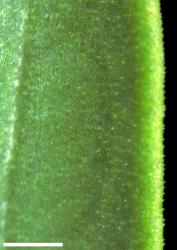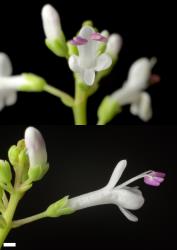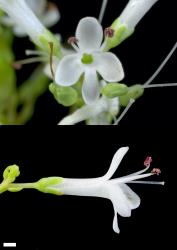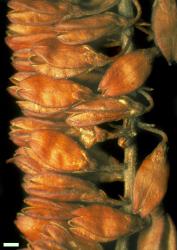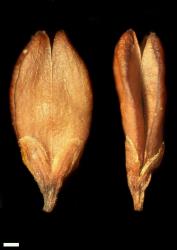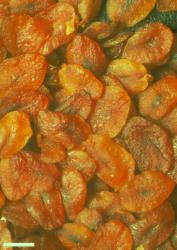- ≡ Hebe traversii (Hook.f.) Andersen, Trans. New Zealand Inst. 56: 694 (1926)
- = Veronica traversii var. elegans Cheeseman, Man. New Zealand Fl. 519 (1906)
Bushy shrub to 2.5 m tall. Stems erect, eglandular-puberulent or -pubescent; hairs usually uniform, rarely bifarious, sometimes sparse. Leaf bud distinct, its leaves appressed at margins until fully grown; sinus absent. Leaves opposite-decussate, erecto-patent to spreading; lamina sub-coriaceous, narrowly oblong to oblong-lanceolate, 16–44 mm long, 2.5–9.0 mm wide, dull, green or pale green above and beneath; midrib and often two lateral veins evident; surfaces glabrous or with sparse, fine, eglandular hairs along midrib and near base above, sometimes hairs short and glandular; margin scabrous, ciliate, or pubescent, entire; apex obtuse to acute, sometimes weakly plicate-acuminate; base cuneate; petiole indistinct, broadly winged, 1–3 mm long. Inflorescence a lateral raceme, 23–73 mm long; flowers crowded, 34–72, female or bisexual on separate plants, ⚥ > ♀; bracts alternate or loosely whorled, lanceolate to ovate, < pedicels; pedicels erecto-patent to spreading, 0.8–3.0 mm long, puberulent all around. Calyx lobes usually 4, sometimes 5 (5th lobe small, posterior), obtuse to sub-acute, 0.8–1.5 mm long, equal, usually mixed glandular- and eglandular-ciliolate or rarely glandular-ciliolate. Corolla 4–7 mm diameter; tube white, 2.5–4.5 mm long, >calyx, eglandular-hairy inside; lobes 4, white or tinged purplish or pink at anthesis, erecto-patent to spreading or recurved, unequal, elliptic to obovate, 2–3 mm long, obtuse to rounded; nectar guides absent. Stamen filaments white, 2.5–3.3 mm long; anthers pink or magenta. Style glabrous, 4–7 mm long. Capsules latiseptate, sub-acute to obtuse, glabrous, 3.5–5.5 mm long, 1.8–4.0 mm at widest point. Seeds ellipsoid, ovoid, or oblong, flattened, smooth, brown, 1.3–2.4 mm long.
parviflora | stenophylla | strictissima | traversii | |
|---|---|---|---|---|
Habit | shrub or small tree up to 12 m tall | shrub to 2 m tall, sometimes sprawling | rounded shrub to 2 m tall | shrub to 2.5 m tall |
Leaf length (mm) | 8–76 | 16–87 | 9–49 | 16–44 |
Leaf width (mm) | 1.5–7.0 | 2.5–10.0 | 3.0–8.0 | 2.5–9.0 |
Leaf margin | minutely hairy | glabrous, or occasionally pubescent | glabrous, papillate, or with very short, antrorse, tapered, eglandular hairs | scabrous, ciliate or pubescent |
Leaf adaxial (upper) surface | smooth | minutely pitted, especially near margins; each pit with a minute glandular hair | smooth | smooth |
Calyx lobes | mixed eglandular- and glandular-ciliate; the glandular hairs with 2 terminal cells | usually eglandular-ciliate; if also glandular, the glandular hairs mostly with 1 terminal cell; hairs with 2 terminal cells rare | mixed eglandular- and glandular-ciliolate, sometimes sparsely so; the glandular hairs with 2 terminal cells | eglandular-ciliolate or mixed eglandular- and glandular-ciliolate; glandular hairs with 2 terminal cells |
Corolla tube | up to 2 × calyx; > corolla lobes | 2–4 × calyx; > corolla lobes | = or slightly > calyx; < corolla lobes | 3–4 × calyx; > corolla lobes |
Corolla tube | hairy inside | usually glabrous; sometimes hairy (especially var. hesperia from NW Nelson) | hairy inside | hairy inside |
Capsule | c. 2 × calyx | c. 2 × calyx | c. 3 × calyx | 3–4 × calyx |
Distribution | North Island, mostly in the east; South Island (coastal Marlborough only) | central and east North Island and outliers near Hamilton; South Island north of a line from Westport to Cape Campbell | South Island (Banks Peninsula only) | South Island (Marlborough, Canterbury south to Four Peaks Range (absent from Banks Peninsula) |
South Island: Marlborough, Westland (near Lewis Pass only), Canterbury (southwards to Four Peaks Range).
Scrub and forest margins, rock outcrops, often in valleys and river terraces. Recorded elevations range from 152 to 1127 m.
Flowers: January–March, but specimens have been collected in flower in all months; fruits: January–June, persisting to November.
2n = 40 (see Bayly & Kellow 2006, as Hebe traversii).
Veronica traversii is classified in V. subg. Pseudoveronica sect. Hebe and the informal group “Occlusae” (Albach & Meudt 2010; Bayly & Kellow 2006).



